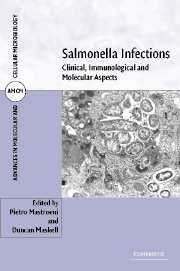Book contents
- Frontmatter
- Contents
- List of contributors
- Preface
- 1 Epidemiological and clinical aspects of human typhoid fever
- 2 Antibiotic resistance in Salmonella infections
- 3 Host-specificity of Salmonella infections in animal species
- 4 Public health aspects of Salmonella enterica in food production
- 5 The Salmonella genome: a global view
- 6 Pathogenicity islands and virulence of Salmonella enterica
- 7 In vivo identification, expression and function of Salmonella virulence genes
- 8 Mechanisms of immunity to Salmonella infections
- 9 Interactions of S. enterica with phagocytic cells
- 10 Interactions between Salmonella and dendritic cells: what happens along the way?
- 11 Immunity to Salmonella in domestic (food animal) species
- 12 Newer vaccines against typhoid fever and gastrointestinal salmonelloses
- 13 S. enterica-based antigen delivery systems
- Index
- Plate section
- References
2 - Antibiotic resistance in Salmonella infections
Published online by Cambridge University Press: 04 December 2009
- Frontmatter
- Contents
- List of contributors
- Preface
- 1 Epidemiological and clinical aspects of human typhoid fever
- 2 Antibiotic resistance in Salmonella infections
- 3 Host-specificity of Salmonella infections in animal species
- 4 Public health aspects of Salmonella enterica in food production
- 5 The Salmonella genome: a global view
- 6 Pathogenicity islands and virulence of Salmonella enterica
- 7 In vivo identification, expression and function of Salmonella virulence genes
- 8 Mechanisms of immunity to Salmonella infections
- 9 Interactions of S. enterica with phagocytic cells
- 10 Interactions between Salmonella and dendritic cells: what happens along the way?
- 11 Immunity to Salmonella in domestic (food animal) species
- 12 Newer vaccines against typhoid fever and gastrointestinal salmonelloses
- 13 S. enterica-based antigen delivery systems
- Index
- Plate section
- References
Summary
INTRODUCTION
Salmonella infections in humans can range from a self-limiting gastroenteritis, usually associated with non-typhoidal Salmonella (NTS), to typhoid fever with complications such as a fatal intestinal perforation. The World Health Organization (WHO) estimates that the annual global incidence of typhoid fever is about 21 million cases with a mortality of 1% (Crump et al., 2004). This may be an underestimate because typhoid is predominantly a disease of developing countries, where not all cases present to the healthcare services and data collection may be difficult. In addition, financial constraints limit outbreak investigation and antibiotics are often widely available without prescription. Not only does this compound problems with data gathering, but it is likely to add to the burden of resistant disease circulating in the community. The situation is even less clear for NTS because most patients do not need to consult the health services. Despite this, as reported in 1999 in the USA alone there were an estimated 1.4 million cases of NTS infection annually, resulting in approximately 600 deaths (Mead et al., 1999).
There is no doubt that antibiotic resistance in Salmonella infections poses a major threat to human health, especially in cases of invasive NTS in immunocompromised patients and in typhoid fever. The cost of resistance in human terms is shown in Table 2.1. There is also a potential increase in the cost of food production.
- Type
- Chapter
- Information
- Salmonella InfectionsClinical, Immunological and Molecular Aspects, pp. 25 - 56Publisher: Cambridge University PressPrint publication year: 2006
References
- 1
- Cited by



